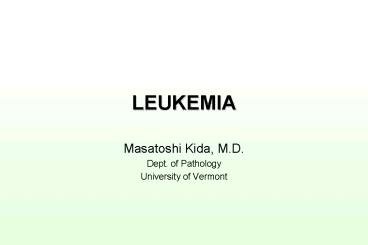LEUKEMIA - PowerPoint PPT Presentation
1 / 23
Title:
LEUKEMIA
Description:
general aspects of lymphoid neoplasms. 1. histologic examination ... common acute lymphoblastic leukemia antigen (CALLA) T-cell antigen (T) --- mostly negative ... – PowerPoint PPT presentation
Number of Views:2048
Avg rating:3.0/5.0
Title: LEUKEMIA
1
LEUKEMIA
- Masatoshi Kida, M.D.
- Dept. of Pathology
- University of Vermont
2
leukoproliferative disorders
- lymphoid lymphoid neoplasms acute
- chronic
- myeloid myeloid neoplasms acute
- chronic
3
Lymphoid Neoplasms
- general aspects of lymphoid neoplasms
- 1. histologic examination is required for
diagnosis - 2. wide range of behavior
- 3. majority are of B-cell origin (80-85)
- 4. disruption of normal immune regulatory
mechanisms - 5. deriving from a single transformed cell
(monoclonal) - 6. homing to and growing in the areas of origin
- 7. tends to spread through lymphatics and
peripheral blood to distant lymphoid tissue
4
Acute Leukemia
- monoclonal proliferation of immature blast
cells that fail to participate in the normal
maturation process - as the cells accumulate, they spill over into the
peripheral blood - morbidity and death are rarely caused by
leukemic cells
5
Acute Leukemia
- general overview
- abrupt stormy onset
- depression of marrow function
- fatigue ? anemia
- fever, infection ? ?WBC
- bleeding ? ?platelet
- bone pain and tenderness ? marrow expansion
6
Acute Leukemia
- - generalized lymphadenopathy
- splenomegaly ALL gt AML
- hepatomegaly
- - testicular involvement ALL gt AML
- - CNS involvement ALL gt AML
- headache
- vomiting
- nerve palsie
7
Acute Lymphocytic Leukemia/Lymphoma (ALL)
- 40 of acute leukemia
- children, young adults
- most frequent malignancy of childhood
- 80 of childhood acute leukemia
- 50 of cancer deaths in children lt15 y/o
- white non-white 2 1
- male gt female
8
Acute Lymphocytic Leukemia/Lymphoma (ALL)
child ALL almost curable adult ALL recent
improvement in prognosis, but still with
significant mortality
9
Acute Lymphocytic Leukemia/Lymphoma (ALL)
- BM failure (pallor, lethargy, abnormal bleeding)
- bone joint pain
- peripheral lymphadenopathy
- splenomegaly
- CNS involvement
- CSF increased pressure and cellularity
- decreased glucose
- normal protein
10
Acute Lymphocytic Leukemia/Lymphoma (ALL)
- Peroxidase-granule negative (? AML)
- terminal deoxynucleotidyl transferase (TdT)
- common acute lymphoblastic leukemia antigen
(CALLA) - T-cell antigen (T) --- mostly negative
- surface Ig (sIg) --- mostly negative
- cytoplasmic Ig (cIg)
- PAS-pos cytoplasmic aggregate
11
ALL peripheral
blood smear
- normocytic, normochromic anemia
- thrombocytopenia
- WBC may be low, normal, or high
peripheral B-cell
pre B-cell
pre T-cell
12
ALL
clinical course
- Remission in the majority of children
- 5 yrs disease free period in 50 of cases
- complete cures possible
- significant recent improvement in survival rate
for T-cell type
13
ALL
prognostic factors
- good bad
- age 2-10 y/o lt1 y/o adult
- sex female male
- WBC gt50,000 blast/mL
- phenotype early precursor B-cell mature B-cell,
null cell - cytogenetics high hyperploidy pseudo-diploid
- t(922)
- 3 of pediatric ALL
- 25 of adult ALL
- t(814)
14
(No Transcript)
15
leukoproliferative disorders
- lymphoid lymphoid neoplasms acute
- chronic
- myeloid myeloid neoplasms acute
- chronic
16
Lymphoproliferative Disorders
- clonal expansions of antigen stimulated
lymphocytes - maturation arrest due to molecular derangements
- primarily B cell origin
- may be induced by chromosomal translocations,
retrovirus, or oncogene activation - 1. chronic lymphocytic leukemia (CLL)
- 2. hairy cell leukemia
17
Chronic Lymphocytic Leukemia (CLL)
- most common form of leukemia in North America and
Northern Europe - essentially identical to small lymphocytic
lymphoma (SLL) - M gt F (2 1)
- elderly (gt60 y/o)
- considered incurable
- mostly asymptomatic
- hepatosplenomegaly may be present
- peripheral lymphocytosis (gt200,000)
- increased susceptibility to bacterial infection
(most frequent cause of death) - may associated with autoimmune hemolytic anemia
18
Chronic Lymphocytic Leukemia (CLL)
- Indolent clinical course
- median survival 4-6 yrs
- occasional transformation to large non-Hodgkins
lymphoma (Richters syndrome) --- 3 to 5
19
Hairy Cell Leukemia
- uncommon variant of peripheral B-cell neoplasm
- clinically middle age to elderly (younger than
CLL) splenic red pulp involvement - histologically lymphocyte with finger-like
projections - phenotypically TRAP (Tartrate Resistant Acid
Phosphatase) - CD19, CD20
20
Hairy Cell Leukemia
clinical
- M gt F (3-5 1)
- splenic red pulp involvement ? red pulp lake
- tends to follow an indolent course
- pancytopenia - most prominent feature
- - granulocytopenia ? recurrent bacterial
infection - - anemia ? fatigue
- - thrombocytopenia ? bleeding
- good response to some chemotherapy regimen
21
(No Transcript)
22
(No Transcript)
23
(No Transcript)































![[PDF] DOWNLOAD HEALING CHRONIC LYMPHOCYTIC LEUKEMIA SIMPLIFIED: EFFECT PowerPoint PPT Presentation](https://s3.amazonaws.com/images.powershow.com/10086247.th0.jpg?_=20240726115)